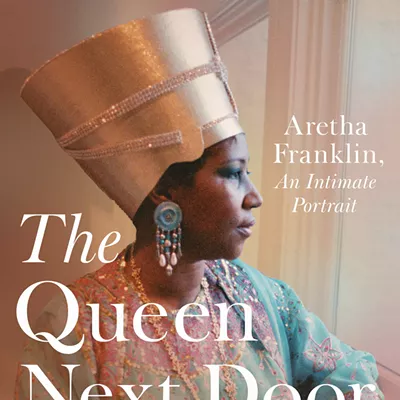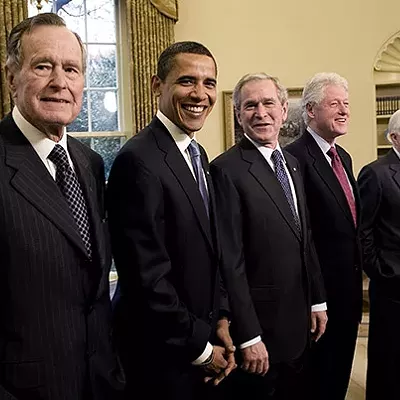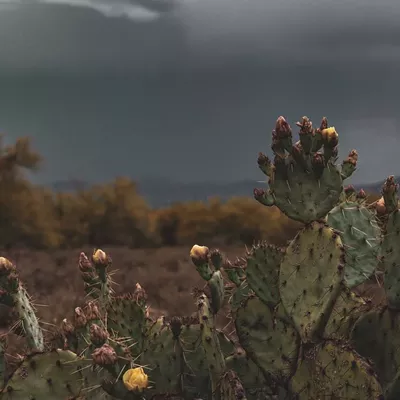Hundreds of people live in the large complex, and it's within the orbit of Los Angeles, one of the world's most populous cities. The building is at least 20 stories high, and its art moderne façade is a slick contemporary composition of horizontals and curves.
By contrast, Fuller lives in the wilderness. As he puts it, he's 13 miles from the nearest town, and 100 miles from the nearest movie theater. His place is big enough. He's added acres over the years; he's built a series of darkrooms; and he expanded the house after he got married. Still, it's sized for one small family. He relishes its solitude, silence and remoteness.
Yet he's spent much of the last 30 years photographing cities. His passion is making stripped-down images of architecture, like that Long Beach apartment building, now on view in his show at the Temple Gallery. At first, there seems to be a disconnect between his home and his subject. But in Fuller's mind--and eye--the urban jungle and the desert wilderness are of a piece.
"I find there is a common bond between the solitude and space in wilderness, and the quiet beauty and vast expanse of city," Fuller writes in his artist's statement. "The canyons, pinnacles and spare compositions exist in both places."
City and wilderness are both places of extremes, way beyond human scale: Think monumental skyscrapers, towering mountains, the city's concrete cliffs, nature's limestone chasms. And like much of the sweeping Western wilds, Fuller's cities are almost wholly unpeopled. In his black-and-white photographs of Chicago, San Francisco, Denver, Houston--the great American metropolises--there is not a single human being. His cameras capture only what people have built, aiming for "the quiet beauty that can still be found in the din of city life."
Fuller avoids the teeming hordes by photographing high and wide with his large-format view camera, avoiding streets at the bottom of the concrete canyons. He pictures towers at their highest heights, scraping against the sky, like the church-like structure in "Houston, Texas--1985." And he's far enough away that the windows on buildings like those in "Embarcadero Center, San Francisco, California--2000" are distant patterns, not portals into the human activity inside.
He rejects the role of urban documentarian or architectural historian, a genre with a rich photographic tradition, from Aaron Siskind's Harlem to W. Eugene Smith's Pittsburgh. Those artists wanted to photograph the essence of place, rendering storefront churches, row houses, paperboys and clotheslines. Fuller does the opposite. As a modernist, he strips such places down to their bare essentials, turning vibrant cities into near abstractions. Most of the time, his anonymous buildings could be Anywhere, USA.
Admittedly, their standardized international design helps. The Embarcadero Center, for instance, could be almost any office block in nearly any prosperous city anywhere in the world, from San Francisco to Dubai. But banal apartment blocks and office towers readily lend themselves to the kind of abstraction Fuller aims for. Devoid of ornamentation, these sheer blocks of concrete have flat windows flush against flat walls. But Fuller is not making an architectural critique. He turns their plainness into pattern, their simple geometries into engaging compositions. His coolly contemplative pictures arrange our built space into a modernist poetry of light and dark.
The Long Beach apartment becomes a rhythmic compilation of line, curve, light and shadow. The Embarcadero buildings are stacked against each other like so many boxes, their black windows and white concrete forming a checkerboard pattern. "Denver, Colorado, 1984" is a formalist assessment of the geometries of the city. Its cubes and trapezoids and blocks thrust into the sky, angling against soft-edged clouds.
Often, Fuller starkly contrasts the built hardscape with the yielding sky, but some of his pictures avoid nature entirely: no sky, no clouds, no earth, no horizon intrude. The architecture takes over the entire picture plane. That's the case with "Chicago Athletic Association, Chicago, Illinois--1981." Sandwiched between two other buildings, this venerable building gets a head-on portrait. Its arches and columns, side by side with strong verticals of the adjoining buildings, make an all-over-flat pattern picture. And the old building's ornamentation gives it some distinction: It's recognizable in a way that Fuller's generic modernist towers are not.
"Bay Bridge, San Francisco, California, 1988" also pictures a street that San Francisco cognoscenti could no doubt identify. At left, a squat 19th-century church adjoins an early 20th-century mercantile building. Across the street, a pagoda-style temple is dwarfed by a massive modern apartment block, horizontally striped in black and white. More than most of the pictures, this one uncovers the archaeology of the ever-changing American city, where historic structures, the old, are routinely pulled down to give way to the new, to progress. Here, at least for now, the eras coexist.
And so do nature and city. For once, the photographer offers a way out. The two solid rows of buildings are photographed in classic perspective, with the blocks thrusting out diagonally to the photo's sides. But the claustrophobic concrete canyon opens up to a distant view of the bridge, the bay and the sky. And from there, it's a short leap back to Pine, Ariz.














